Module 2. Asset management fundamentals
Overview
So, let’s remind ourselves of what assets are.
An asset is a resource having economic value that is owned or controlled by an individual or company with the intention that it will deliver a future benefit to the owner or controller. The International Standard for Asset Management (ISO 55000) defines an asset as any object, thing, or entity that offers potential or current value to an organisation. The value can be material or intangible, financial or nonfinancial in nature, and it also considers risks and responsibilities.
Asset management (AM) and project management are heavily interrelated. Asset portfolio planning is difficult without the planning data provided by projects. Based on the project information, the project portfolio manager may be required to undertake a scenario analysis, which shows how all projects will evolve in the future, considering all their tasks, activities and their interdependencies and timelines. AM is impossible to accomplish without the assistance of project management, and vice versa. AM is therefore essential for projects, and portfolio managers working in organisations with a significant emphasis on assets. It is important for project managers to become familiar with AM and begin aligning their operations with the AM system of the project host organisation.
Like project management, AM is cross-disciplinary and easily applied to various fields. Financial, enterprise, infrastructure, public, information technology, fixed, and digital AM are all types of AM used interchangeably in the business context. However, as the definition of AM may vary from one company or department to the next, the majority of AM can be simplified and divided into three types: physical, financial, and contractual.
- Physical asset management: includes the process of dealing with things like fixed assets, stock control, infrastructure, and publicly owned assets.
- Financial asset management: is defined as the process of managing procurement, formulating an investment plan, regulating budgets and expenses, and dealing with financial instruments such as cash, bonds, and stocks.
- Contractual asset management: compliance with contractual obligations simplifies business operations such as technology asset management, digital asset management, contractual maintenance, and the management of intangible assets, among other things.
In the field of AM, everyone has a role to play. For senior management and the organisation’s directors to be proactive, they must consider the organisation’s variety of stakeholders, how they are involved in asset management, what their expectations are, and how these expectations will be met and communicated.
It is important to note that AM is also closely linked to the change management process. This is a function that must be created as a foundation to allow the baselining of project deliverables and project change control. This activity entails identifying both deliverable and non-deliverable goods, as well as building an appropriate organisational structure for project assets to effectively govern and manage them. Therefore, a plan for AM should also be devised. The precise AM procedures and particular security protocols should be included in this plan as well as all the stakeholders’ requirements. The business has invested in project deliverables, which are important assets. It is then up to the project manager to initiate the AM plan, and if needed, assign this task to the asset manager while jointly working in its execution up to the deliverable phase.
The first step in adopting good AM is to figure out what function customers play and what type, form, and shape of documentation they require. It also entails determining the scope of project deliverables that are subject to change control and the asset manager’s responsibilities. Although the principal asset of a project can be highly diverse, in practice, as mentioned before, the scope is frequently limited to tangible and intangible assets, for example, software application vs training documentation. User requirements documentation, scoping documents, functional specifications, and acceptance test scripts/data are also examples of deliverables that may be subject to AM. However, AM may also apply to non-deliverables such as vendor proposals (which may be necessary for procurement – purchasing of projects), user procedures, team training guides and manuals, and any other general operations documentation.
For AM to make a significant contribution to an organisation’s success, important activities, connections, and procedures must be identified, formed, and managed inside the business. In other words, an AM framework must be investigated, with fundamental AM procedures and enablers established as part of a comprehensive approach to achieving the organisation’s strategic goals. Therefore, keep in mind that the right AM approach needs to align with the organisation’s strategy and by establishing an effective asset life cycle the right AM framework can be achieved.
However, the field of AM is a relatively new field in project management, and hardly any study has been conducted up to now on the factors that firms consider essential to their strategic performance. As a result, existent AM frameworks tend to be devoid of theoretically sound foundations. Therefore, you will find many AM framework variations and blueprints in the market, including software applications and asset management brokers. And to answer the question you have in mind now: no, there is no unique model. We, project managers and our teams, tend to make the necessary assessments to adopt the most effective framework, keeping in mind the organisation’s structure, processes, and overall strategy.
Assets are there to add value to the business, but it is the AM process that assures that assets can generate this value. Therefore, if we have identified key milestones in the way we (i.e.. the organisation and project management team) operate to attain value, we are closer to developing an effective AM framework. Figure 3 highlights some of the key contributing factors that, in project management, enable the process of changing assets into value, as well as a holistic AM process to deliver effective project outcomes.
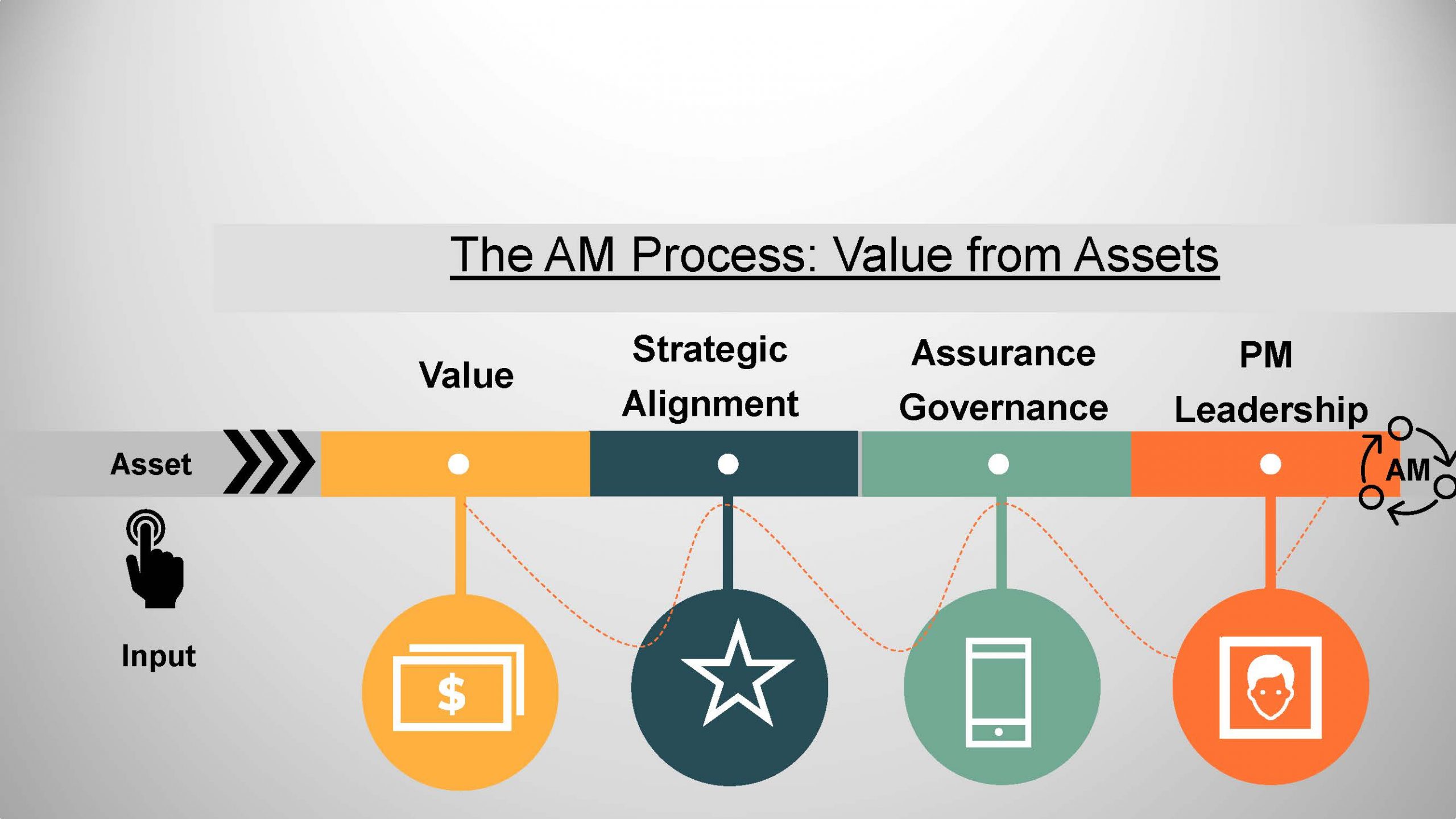
One of our primary goals as project managers is to produce value from our project deliverables. Yet, to be able to do that, project managers need to understand and support the asset life cycle and not confuse it with the actual life cycle of the projects we are managing; there are significant differences between both. Let’s discuss them.
What is the asset life cycle and how does it work?
It is a good business strategy to maximise the cost-effectiveness and efficiency of assets throughout their usable lifespan. This is often referred to as asset life cycle management. The life cycle of an asset includes everything that takes place from the time it is first determined that the item is required to the time it is finally disposed of. Using asset life cycle management, the management team together with the project manager may maximise the usable life of their assets while minimising the amount of money spent on them over the course of their service lifetimes. Achieving effective asset life cycle management may help us lengthen the life of our assets, lower the cost of maintaining them throughout their lives, and make our assets more dependable and less prone to break down. In the previous module we introduced four stages that form the asset life cycle phases. However, this was done in a generic way. Let’s expand on those now.
Asset life cycle management phases
Please note that there are a few variations in the literature on the number of phases within the life cycle. You will see some references to four, while in others five or six. We are providing you with a more contemporary asset life cycle.
Phase 1. Planning
The first stage of the asset life cycle is the planning stage. Note that this is different to the planning phase of the project, which is the second phase as it can only start once the design phase is completed.
In this phase, you need to determine and validate the asset requirements with all the stakeholders internal to the organisation. The evaluation of current assets and their capacity to satisfy the organisations’ service delivery objectives is necessary to identify the asset requirements. Identifying and analysing management strategies and communication requirements are equally important tasks in the analysis of the requirement for an asset. This step is significant in the conceptualisation of the asset and in seeking agreement with its requisites. When designing a project, it is critical to consider how the continuing development will benefit the organisation at all stages of the process and the same applies here. The value of the asset should be planned across its entire life cycle.
Figure 4 shows some of the benefits that will accrue to the organisation if an implementation of excellent planning is in place.
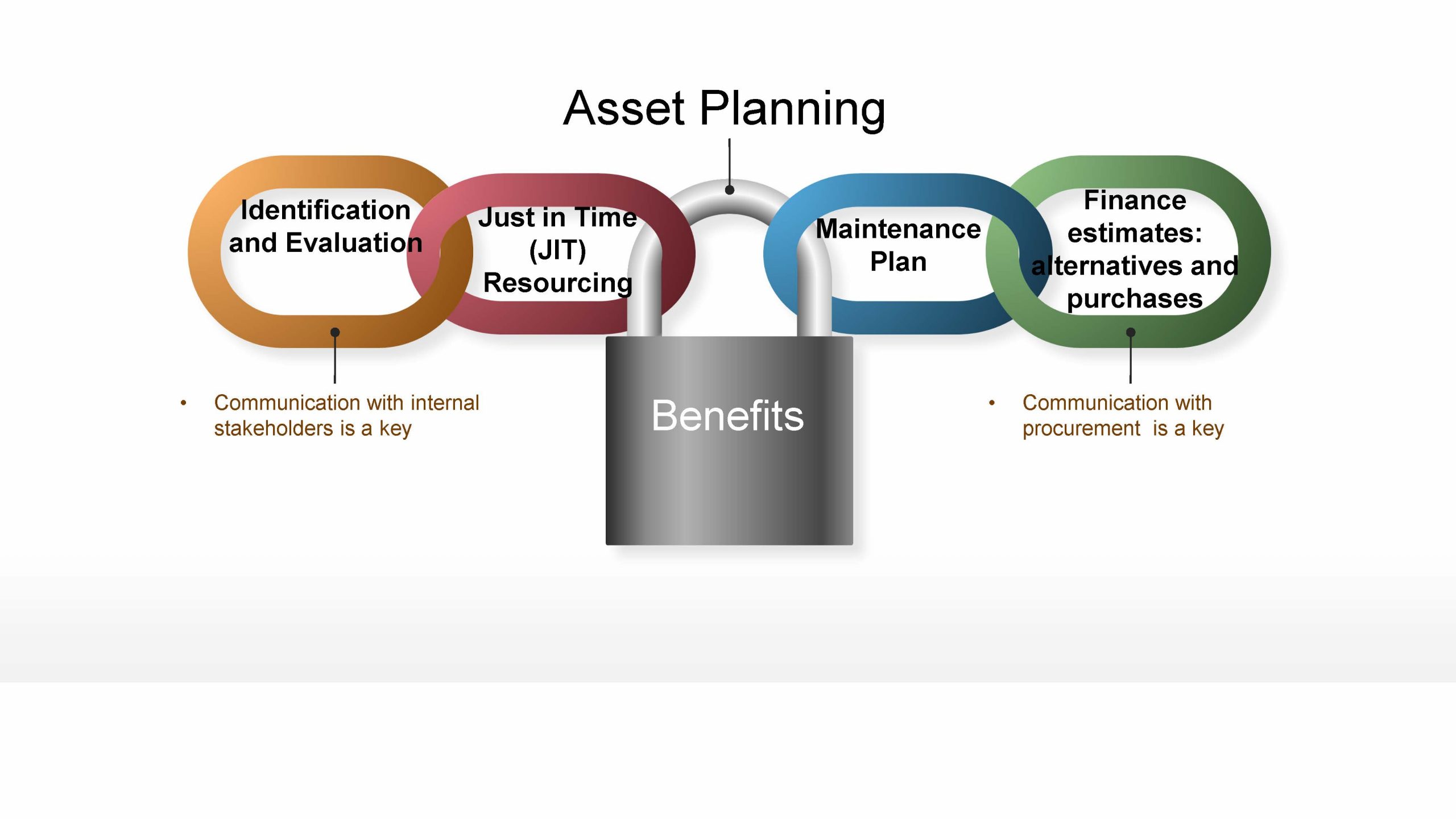
In sum, excellent planning at all phases of the AM cycle allows an organisation to achieve the following results:
- Identify assets that are overperforming and ones that are underperforming.
- Check to see if the organisation’s current assets are sufficient for its requirements.
- Make certain that assets are well-maintained and that they are responsible.
- Ascertain that assets are readily available when they are required.
- Analyse alternative asset selections in light of your financial planning.
Phase 2. Procurement
Procurement is the first process or stage in the maintenance of an asset’s life cycle, and it is the stage in which the asset is purchased. This section can be outsourced to the project management procurement team if the organisation’s structure is project based. The best asset selection will be made based on the possibilities available to meet the needs of the company while staying within the budget constraints. Typically, the purchase is done after careful consideration of the demands that have been recognised from the research data collected, and the projections which are then developed on value gain to further support the actual purchase.
Once an asset has been acquired, it becomes the property of the organisation and can be utilised in any way that is deemed appropriate and profitable. The minimum work requirement within this phase of the asset life cycle is described in the flowchart below (Figure 5).
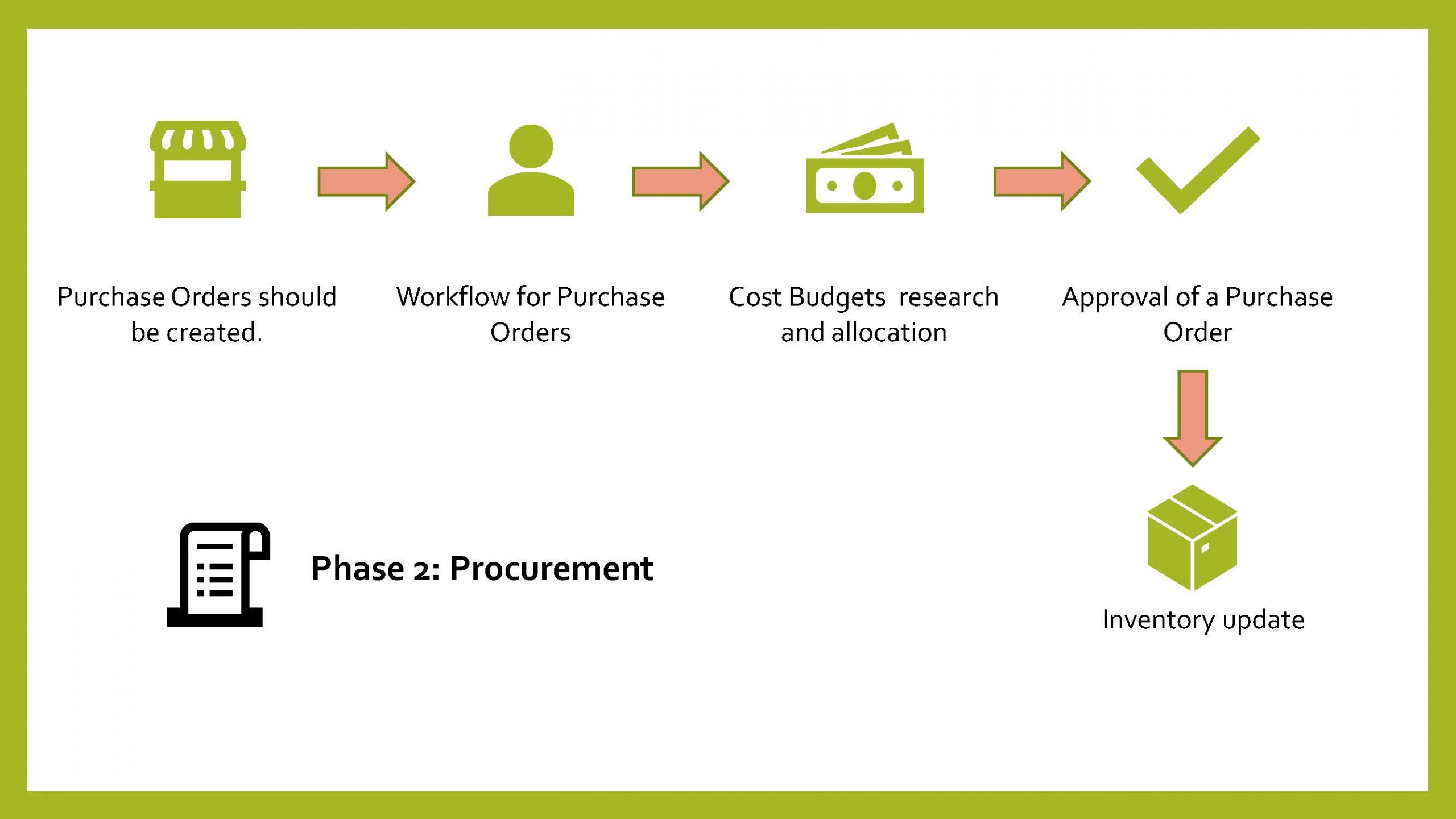
It is important to note that each organisation is likely to have its own procurement and acquisition processes. Project managers need to aware of the different policies and procurement regulations existent within the project’s organisation. However, even if these differ, a ll actions associated with buying an asset are standard, with an ultimate objective: ensuring that the acquisition of the asset is as cost-effective as feasible in the long run. Project managers will be regularly liaising with the procurement department as this department, under any organisation structure, is responsible for identifying the most qualified suppliers and negotiating the most favourable terms. Therefore, during this phase, the project manager is required to have excellent communication skills.
When all criteria from both phases, planning and procurement, have been satisfied, a project team should be formed to oversee the acquisition process, ensuring that all tasks are completed in order to satisfy service delivery and other organisational objectives as soon as possible.
Phase 3. Distribution of resources
The distribution phase, also known as the deployment stage, is the phase in which all the action takes place prior to the asset being used for its intended purpose. The asset is gathered, and it is subjected to preliminary inspections before being distributed to the assigned department for use. The inspection is carried out to look for physical faults (if it is a tangible asset) and design and engineering issues, as well as to determine whether the asset has been placed appropriately and safely. If the asset is intangible, the inspection consists of assessing if the asset is meeting the objectives’ needs and its initial purpose. More likely, in this case, the related stakeholders will also get involved in finalising the inspection.
In addition, various tests are carried out to establish if there any problems. Tests are carried out by assigning the work breakdown structure (WBS) identification (ID Code) for tracking reasons. Once the tests are finalised and coded, the asset is deployed and moved from the inventory system to an “in-use” status. The in-use status should also reflect dates of the WBS.
Phase 4. Operation
The operation phase, also known as the utilisation stage of asset life cycle management, is the most laborious. In this phase, the asset is set to operate and be in use for the purpose for which it was acquired. During this phase the asset documentation (i.e., internal assessment communication artefacts) need to reflect transparency on the organisation’s asset revenue or loss.
During the operation phase, the performance of the asset is constantly monitored for any faults that may occur unexpectedly while it is in use or in its application if it is an intangible asset, and any problems are reported immediately. During the operation stage, the most important thing to remember is to obtain the most utility and production out of the asset.
Purchase of additional licences, compliance audits, and cost-benefit analyses are all examples of activities that fall within this phase. For these activities there are many asset tracking application software programmes on the market. Capterra Digital Management Software for Australia is a good place to start researching the asset tracking trend software in Australia.
Phase 5. Maintenance and repair
It is important that project managers are in the lead in this phase. As innovations in technology move fast, new upgrades and maintenance are needed. When an asset is used continuously, it will also experience wear and tear, which will result in the need for routine maintenance. Maintenance is important because it helps to extend the asset’s useful life as it ages. In this phase, ongoing modifications, patch repairs and upgrades are carried out to bring the asset up to date with the times, making it quicker and more efficient. This will only serve to raise the overall standard of the job. After you have completed the necessary maintenance, you should continue to monitor the assets and search for opportunities to enhance or change its operational needs.
Three main tasks are required in the maintenance and repair phase. These are highlighted in Figure 6 below.
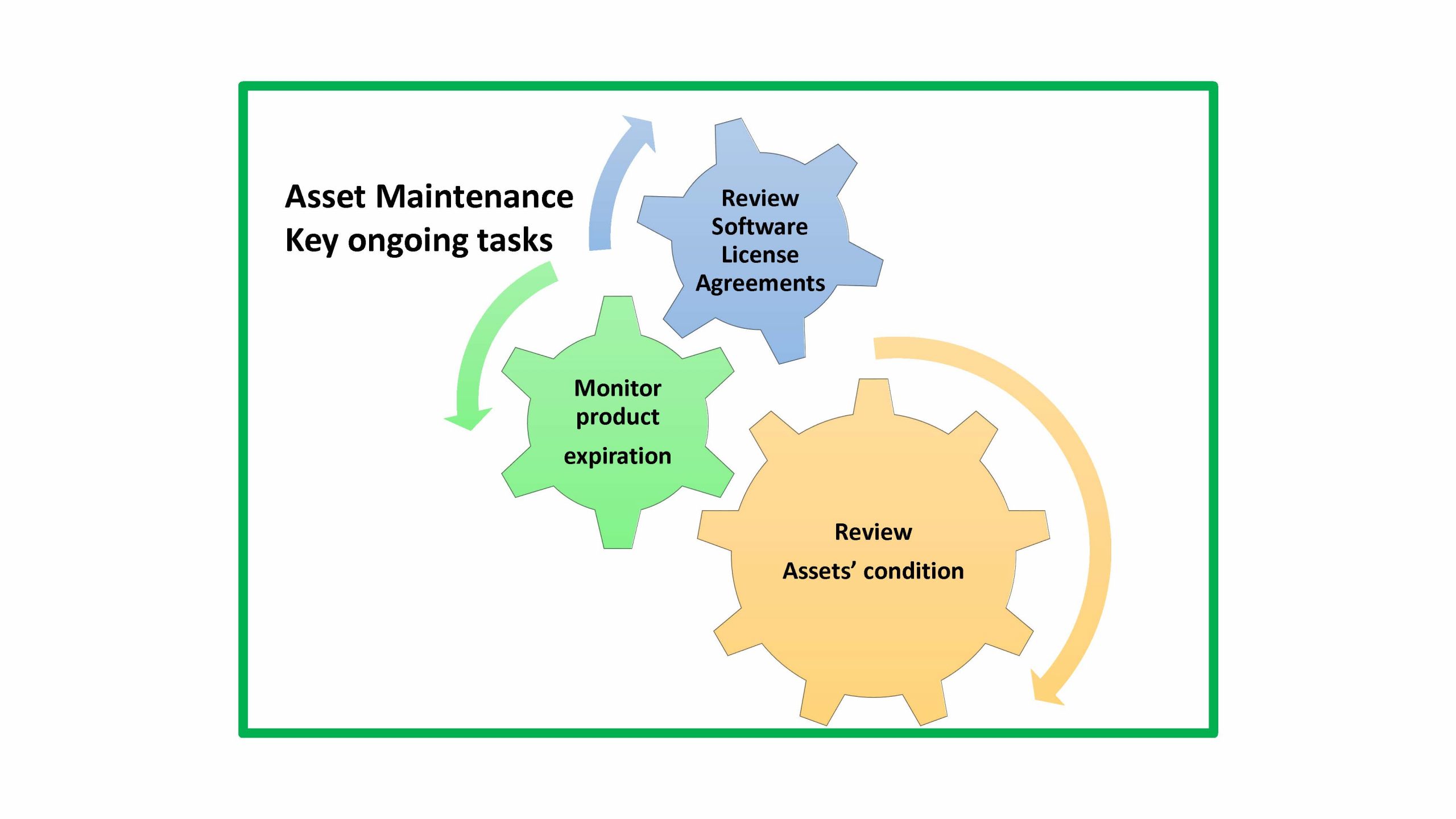
At this point, you are utilising the asset in the manner proposed. Because it constitutes the most significant portion of the lifespan, you may also find that this stage is also referred to as the useful life. While addressing the key tasks of this phase including, ongoing review of the asset’s condition, keeping an eye on licences renewals and product expirations, you should concentrate your efforts on keeping the asset in excellent working order so that it can continue to offer the service you require. As a project manager you may not do this hands-on; however, you will need to consider these ongoing activities while planning and developing the WBS. It is critical to take good care of the organisation’s long-lived assets, whether that means cleaning on a continuous basis or executing some other type of routine maintenance on a regular basis. Certainly, these tasks need to be allocated under the responsibility matrix to in-house staff coordinators. IT asset management, for example, will include frequent data backups, virus scanning, and other updating software procedures. The better maintained an item is from the start, the longer it is likely to endure.
Phase 6. Disposal of waste
It is necessary to dispose of an asset when the item’s usable productive life has expired. Phase six of the AM life cycle is the disposal process of the asset. Decisions regarding the disposal of an asset are recommended to be based on the services that are provided. Before disposing of an asset, this needs to be thoroughly inspected, treated, and processed to ensure that a) it is at the disposal stage, b) it will not cause harm to the environment, and c) it is no longer needed.
To make a correct decision to dispose of an asset and whether or not the value of the asset has been effectuated, sufficient data needs to be collated. Depending on how soon an asset approaches the end of its useful life, it might be classified as a surplus or, alternatively, as an underperforming asset. Removal should be considered from the standpoint of the decision’s implications on performance. If an asset is to be sold soon in order to allow for statutory maintenance to be performed, the maintenance strategy should be properly altered to account for this.
If the asset is to be disposed of, depending on the type of asset data deletion may be required. For example, software or applications that have been issued with a disposal note will be removed from the system. It the asset is a tangible one, it is then deconstructed piece by piece, with all the pieces that may be reused being saved and the parts that are no longer needed being shipped to the right place of disposal.
Project managers and asset managers are required to change the state of the asset in all related documentation from being in use to being expired or disposed of.
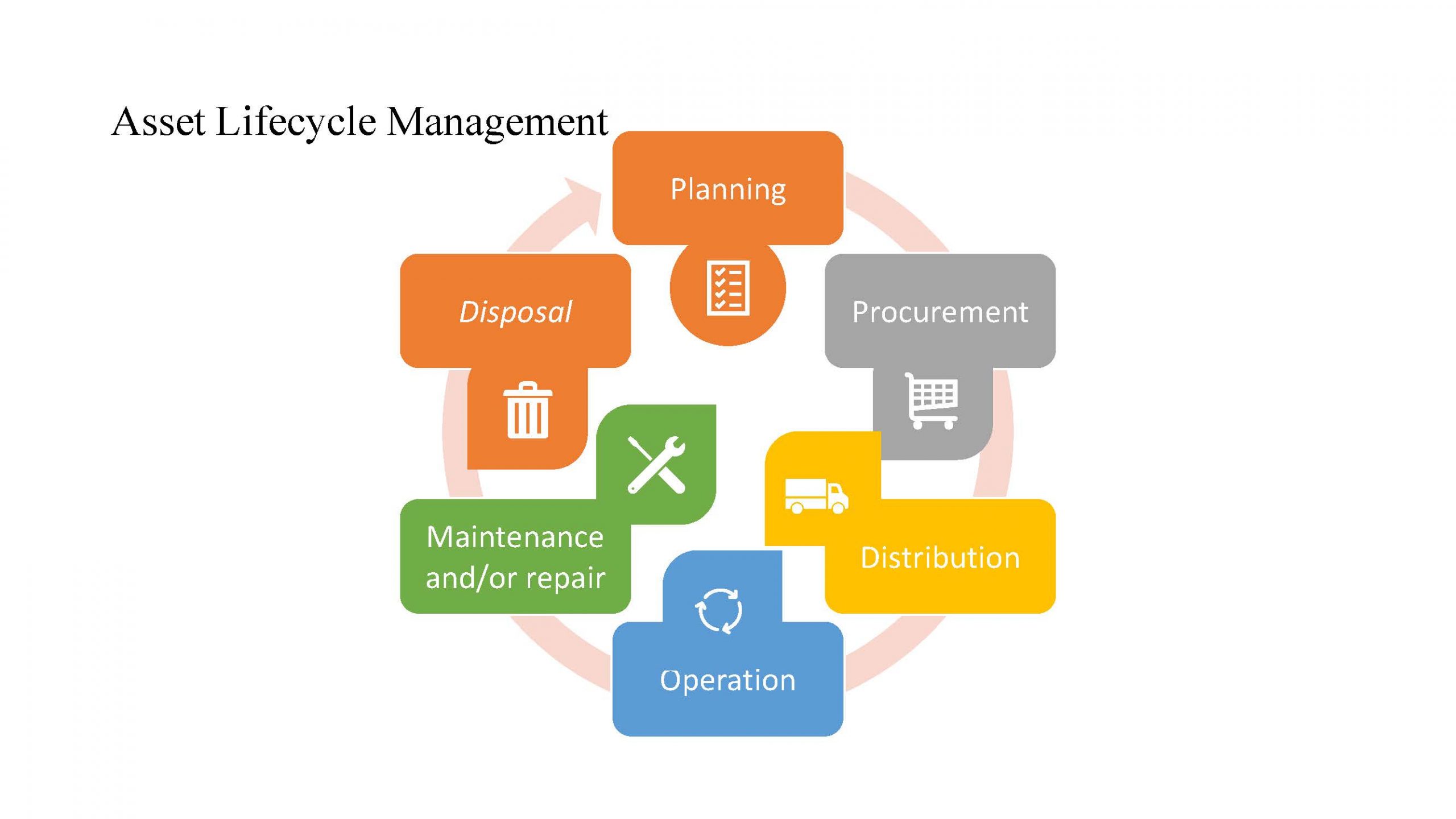
Aspects of asset life cycle management that are beneficial
There are several advantages to measuring, controlling, and improving the life cycle of assets. Here are a few examples.
Increase the useful life of an asset. In other words, increase the asset’s operational life expectancy.
Keeping track of an asset’s lifespan provides you with vital information about how it is performing and when maintenance or an update is most beneficial. Make use of this information to develop an asset lifetime plan that highlights the most effective maintenance intervals and methods for keeping the asset in peak performance.
As a project manager you have already been trained to mitigate. When you intervene with preventive maintenance at these important intervals, you may significantly increase the asset’s operational life.
Reduce the amount of time that your business is inoperative.
Following an asset life cycle management plan decreases the requirement for reactive maintenance, which in turn reduces the amount of time that a facility is down. Preventive maintenance should be performed before the need for reactive maintenance emerges, allowing the project team to maintain control over the asset’s downtime. Preventive maintenance also decreases the likelihood of unplanned, excessive downtime as a result of emergency reactive maintenance that occurs unexpectedly. Maintenance can be scheduled outside of normal facility operation hours to ensure that it does not interfere with employee productivity.
Increase the overall efficiency of the asset.
Another advantage of asset life cycle management is the improvement in the overall quality of the equipment or service. Regular maintenance and review preserves the assets in their best possible shape and helps to avoid disruption caused by inadequate upkeep. Factors that contribute to greater asset efficiency include well-maintained equipment, superior operational service, longer asset lifespans, and fewer equipment downtimes.
Focus on cost savings.
An organisation that is efficient is also a low-cost operating business. All of the advantages listed above will result in cost reductions, therefore the following propositions are considered to be valid when adopting and executing efficient asset life cycle management.
Consider the following three propositions:
- Longer equipment lifespans result in less frequent replacement of equipment, resulting in cost savings.
- Reduced downtime eventually translates to increased uptime, which translates to increased productivity, resulting in cost savings.
- Reactive maintenance is more expensive than preventative maintenance. Therefore, preventative maintenance results in cost savings.
Asset life cycle management allows you to schedule maintenance ahead of time, allowing you to save significant amounts of money on maintenance expenditures.
Make your decision-making processes more informed.
Asset life cycle management provides information about your facilities that would otherwise be unavailable. This information may be used to educate your decision-making process and assist you to create better preparations for the future. For example, while making judgements on an asset’s replacement or repairs, financial and operating tracking data can assist with making the most cost-effective decision.
At this point, a best asset maintenance method should be followed.
Having discussed what asset life cycle management is and what it can do for organisations, let’s move on to the topic of how to put it into practice.
A well-planned asset maintenance approach extends the life of the organisation’s assets and improves their performance. As mentioned earlier, it also implies that there will be fewer malfunctions and associated maintenance for the assets.
The act of doing asset maintenance entails ensuring that your assets are in excellent working order. Furthermore, assets in excellent condition ensure that your facility operates at peak performance, resulting in cost-savings.
In order to obtain insight into the performance of the organisation’s acquired assets, project managers are expected to employ asset monitoring techniques. These techniques allow them to make improvements and optimise assets’ operations, as well as follow asset maintenance best practices to assist organisations to remain in good operating condition while keeping expenditures to a minimum. Here are some asset monitoring best practices to help increase the efficiency of the project manager and team operation.
Asset tracking
Asset tracking best practices for implementation include the following:
- Create a unique identification code for each asset. The creation of a unique code to monitor all assets may appear to be an overly apparent step, but it is undoubtedly the most critical component of a highly effective asset tracking system. Many facilities rely only on serial numbers to keep track of their assets, yet serial numbers can occasionally be reused across many assets and models of the same type of asset. Using serial numbers also offers space for human error, if the number is mis-recorded or mis-translated across several systems. Changes in technology have also given an alternative to this task. Consider utilising a unique QR code for each asset. QR codes may be printed right onto an asset, making them instantly available and linked to a wider set of descriptive data. This guarantees that technicians always have vital information about each individual asset when needed.
- Pay close attention to the details. As soon as all assets have been identified by a unique identification or QR code, it’s time to enter them into your system. This creates a well-informed asset inventory. This is not an agile project management sprint step, but it is a process that must be completed.
- Compile and arrange information
At this point, project managers and teams should have an orderly network of assets that have been labelled, as well as mechanisms for keeping them structured; it is now time to fill in the gaps. Storing all essential data about the assets in a central location will allow technicians to refer to the information quickly and simply, streamlining their tasks and increasing their productivity. More crucially, it produces a complete image of an asset, which can be retrieved at any time to support decision-making. After a period of time, patterns begins to emerge in asset wear and performance, which will allow you to make data-driven decisions.
- Make a consistent plan
The final step in ensuring a successful asset-tracking installation is determining which metrics will be tracked and how they will be tracked. The decision on where to concentrate efforts is influenced by the objectives the organisation wishes to attain. With asset monitoring, the organisation will be in a position to manage downtime, productivity, maintenance history, costs, and a variety of other metrics needed for the successfully meeting the deliverables of the project.
Following that, the team must select how they will keep track of the information. All of the duties listed above can be carried out using project asset and project equipment maintenance software, which provides the tools needed to track nearly everything that falls under the umbrella term of asset-tracking. However, always make sure that the project team is on board, regardless of what needs tracking or how it is intended to be tracked. If project managers want their team to be successful in asset tracking, it’s critical that they understand and are familiar with the technological stack that is being used to assist this process. This includes feeling comfortable inputting, retrieving, and utilising data. The greatest and most accurate outcomes will be achieved when everyone is working from the same page, whether it’s a Word document or a project management asset software system.
Asset monitoring standard practices are essential for long-term success.
- Plan for the future
It is possible to see into the future thanks to asset monitoring, which is one of the most significant advantages it provides. Defining the asset’s lifespan and tracking the progress of each piece of asset throughout its life cycle ensures optimum productivity. Forecasting is the most effective approach applied to the information on asset lifespan and it is a critical step for preparing ahead. Implementing a preventative maintenance schedule where practicable or providing funding for replacements and repairs when a piece of equipment is nearing the end of its useful life, are examples of how to do this. By looking to the future to forecast the next move of the organisations’ assets, we can assure that the organisation will always have the resources needed to keep operations running smoothly.
- Establish performance goals and objectives
While storing information on the performance of the assets is beneficial, it is also necessary to establish goals to put the information into context. Without a reference point, assigning a simple benchmarking number is meaningless. Considering that every organisation is unique, the performance and maintenance objectives set should be tailored to the specific requirements of the organisation. Project managers can hold their team more accountable and employ maintenance management tactics to achieve specific goals if there are clear established productivity expectations way in advance.
- Continuous improvement
The tracking of assets is a never-ending process. Following the implementation of a tracking system, feedback starts being recorded. Once feedback is analysed, the project manager may begin making improvements to increase efficiency. Nevertheless, it is vital to remember that this is not a one-time event: it is a continuous improvement cycle. It will take time and patience to get a completely optimised facility as a result of tracking assets and observing patterns over time. The information gathered on the assets should be reviewed on a regular basis, and always with an eye toward identifying areas where improvements can be made.
Asset monitoring provides valuable information about the operation of every piece of asset in the organisation. It is therefore important that we learn these asset tracking best practices because in the long term it will help us better understand asset productivity.
Test your knowledge
Key Takeaways
- Any company’s performance depends on the effectiveness of its AM department, particularly because infrastructure assets with a lengthy life cycle and requiring significant capital expenditure will serve as the foundation of business growth. As a business grows in size and complexity, the need for a sound asset management strategy becomes even more critical to its success.
- Putting in place an asset management strategy won’t yield results if the process itself is only average at best, as it is often done quickly in response to ongoing changes in the business environment. Before searching for ways to streamline this process, it is vital for organisations to simplify their current asset management procedures first. As the project manager you must be focused on the following areas in order to succeed in the implementation of an effective AM strategy:
| PM Focus | Reflective Questions |
| 1. Recognise the rationale for the presence of an asset. | What is the function of this asset in your organisation?
What was the reason for its acquisition? |
| 2. Acquire information about the asset’s current state. | What is the asset’s current state of health?
How successfully does it accomplish its objectives? Is it a dependable source? |
| 3. Check to see how efficiently the asset is being utilised.
|
What kind of value does the asset now provide?
Is it living up to the expectations that have been set? |
| 4. Determine the needs of the future: forecast! | Would there be a shift in customer expectations for service?
Is the asset capable of meeting current and future requirements? |
| 5. Evaluate the current preventive maintenance approach. | What steps are being taken to ensure that the asset’s lifetime is maintained and improved?
What is the current effectiveness of the asset maintenance approach? Is the forecast for maintenance expenses correct? |
| 6. Predict the depreciation rate and the dangers connected with it. | Is it necessary to examine the asset’s useful life on a regular basis?
Is there a big difference between current expectations and earlier estimates? What will be the ramifications of this depreciation? |
| 7. Predict the disposition of assets. | When is it anticipated that the asset will be permanently removed from service?
If an asset is sold, is there a financial statement entry for the gain or loss resulting from the sale of the item? |
References
International Organization for Standardization. (2014). Asset management — management systems, Guidelines for the application of ISO 55001, ISO 55002:2014(E), 2014. https://doi.org/10.1007/978-94-007-2724-3
PMBOK guide. (2021). A guide to the project management body of knowledge (7th ed.). Project Management Institute.

